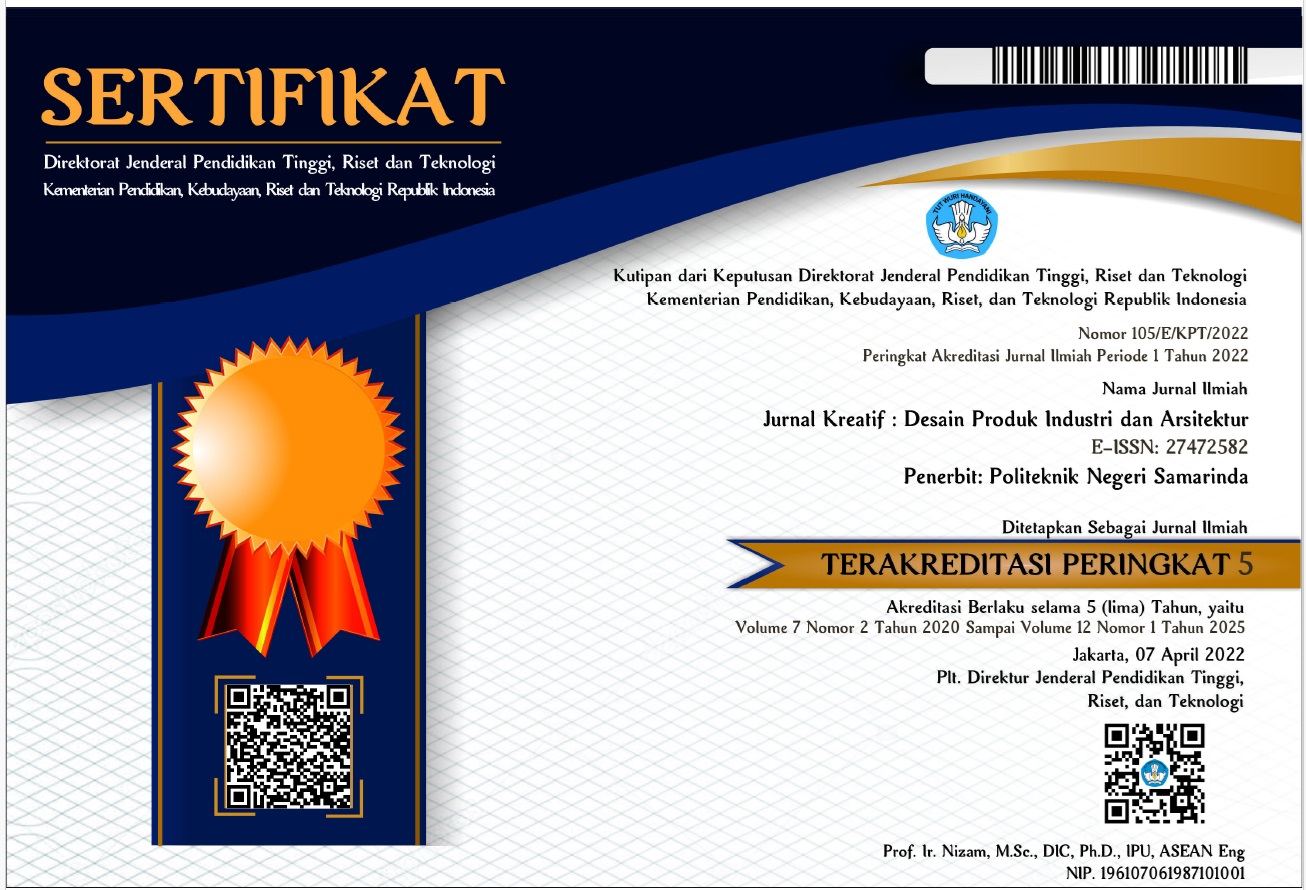REDESAIN KANTOR IMIGRASI KELAS I TPI SAMARINDA PENEKANAN PADA ORGANISASI RUANG DAN GAYA ARSITEKTUR NEO VERNAKULAR
 Abstract views: 192
,
Abstract views: 192
,
 PDF downloads: 191
PDF downloads: 191
Abstract
The Class I Immigration Office of TPI Samarinda is one of the technical implementation units of the regional office of the Ministry of Law and Human Rights of East Kalimantan. It has the duty to carry out some of the main tasks and functions of the Ministry of Law and Human Rights, namely providing travel documents and residence permits for both Indonesian citizens and foreigners, particularly in the areas of Samarinda city, Bontang, Kutai district, and Mahakam Ulu. As a public service office, the Immigration Office faces several challenges, including poorly planned spatial organization, lack of adequate photo studios, separate service areas, and unplanned space additions, all of which hinder the primary activities and functions within the office. The redesign of the Class I Immigration Office of TPI Samarinda emphasizes spatial organization and incorporates the architectural style of Neo Vernacular Dayak Kenyah. This emphasis aims to facilitate both visitors and employees in carrying out activities within the office through the application of a grid spatial organization. The application of the Neo Vernacular Dayak Kenyah architectural style includes the form, facade, and building ornaments.
Downloads
References
Adham Putra, H. M., & HS, C. O. (2023). Implementasi Penataan Lay Out Ruang Dan Kawasan Pada Redesain Bangunan Pemerintah Studi Kasus : Kantor Desa Purwajaya Kabupaten Kutai Kartanegara. Jurnal Kreatif : Desain Produk Industri dan Arsitektur, 11(1), 30–36. doi:https://doi.org/https://doi.org/10.46964/jkdpia.v11i1.286
Ching, F. D. (2007). Arsitektur Bentuk Ruang Tatanan. Jakarta: Erlangga.
Ghina Fajrine, A. B. (2017). Penerapan Kosep Arsitektur Neo Vernakular pada Stasiun Pasar Minggu. Paper presented at the Seminar Nasional Cendekiawan ke 3, Jakarta
Hidayati, Z., Noviana, M., Fitria, D., Thamrin, N. H., & Hayati, A. N. (2023). Perencanaan Rusunami Rumah Difabel Di Samarinda Penekanan Pada Aksesibilitas. Jurnal Kreatif : Desain Produk Industri dan Arsitektur, 11(2), 9. doi:https://doi.org/10.46964/jkdpia.v11i2.425
KKBI. (2024). Kamus Besar Bahasa Indonesia (KBBI). Retrieved from https://kbbi.web.id
Kusumaningrum, T. A. (2018). Jelajah Arsitektur Lamin Suku Dayak Kenyah (K. Karesina, ed.). Jakarta Timur: Badan Pengambangan dan Pembinaan Bahasa.
Marlina, H. (2019). Kajian Semiotik Motif Pakaian Adat Dayak Kenyah Di Desa Pampang Samarinda Kalimantan Timur. Ars: Jurnal Seni Rupa Dan Desain, 22(1), 45–56. . Retrieved from https://doi.org/10.24821/ars.v22i1.2524
Meilyana, Y., & H.P, D. P. (2020). Peran Kantor Imigrasi Kelas Ia Samarinda Dalam Pengawasan Dan Penindakan Orang Asing Berdasarkan Undang – Undang Nomor 6 Tahun 2011. Legalitas, 5(2), 48. doi:https://doi.org/10.31293/lg.v5i2.5035
Noviana, M. (2013). Konsep Arsitektur Berkelanjutan Arsitektur Vernakular Rumah Lamin Suku Dayak Kenyah. Jurnal Kreatif : Desain Produk Industri dan Arsitektur, 1(1), 10. doi:https://doi.org/10.46964/jkdpia.v1i1.112
Samarinda, B. P. (2023). Kota Samarinda Dalam Angka 2023. Retrieved from Badan Pusat Statistik. Retrieved from https://samarindakota.bps.go.id/publication/2023/02/28/ace19ab2ed48fb5c794cb13d/kota-samarinda-dalam-angka-2023.html
Widi, C., & Prayogi, L. (2020). Penerapan Arsitektur Neo-Vernakular pada Bangunan Buday dan Hiburan. Jurnal Arsitektur ZONASI, 3(3), 282–290. doi:https://doi.org/10.17509/jaz.v3i3.23761
Copyright (c) 2024 Paramita Waluyo

This work is licensed under a Creative Commons Attribution-ShareAlike 4.0 International License.
Authors who publish with this journal agree to the following terms:
- Copyright on any article is retained by the author(s).
- The author grants the journal, right of first publication with the work simultaneously licensed under a Creative Commons Attribution License that allows others to share the work with an acknowledgment of the work’s authorship and initial publication in this journal.
- Authors are able to enter into separate, additional contractual arrangements for the non-exclusive distribution of the journal’s published version of the work (e.g., post it to an institutional repository or publish it in a book), with an acknowledgment of its initial publication in this journal.
- Authors are permitted and encouraged to post their work online (e.g., in institutional repositories or on their website) prior to and during the submission process, as it can lead to productive exchanges, as well as earlier and greater citation of published work.
- The article and any associated published material is distributed under the Creative Commons Attribution-ShareAlike 4.0 International License













